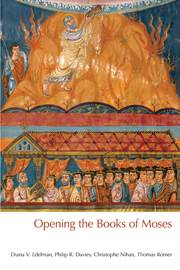2 - The Shape, Dating and Audience of the Pentateuch
Summary
Introduction to the Contents and Shape of the Pentateuch
The Pentateuch comprises a long narrative beginning with the creation of the world and humanity and ending with Moses' death at Mount Nebo facing the Promised Land. In that narrative it is possible to identify several distinct episodes: the origins of humanity, the ancestors of Israel, Israel's sojourn in Egypt and the exodus, and so on. All these episodes are arranged in a chronological framework, and the impression that they form a linear history is reinforced by the giving of the age of the characters in addition to other various chronological notes. Moses is said to have died at the age of 120 (Deut. 34:8), and the exodus is supposed to have happened after the Israelites had sojourned in Egypt for 430 years (Exod. 12:40–41; Gen. 15:13 predicts there will be 400 years of oppression in Egypt). This chronological system is not restricted to the Pentateuch: it can be traced further in the Former Prophets (the books from Joshua to Kings). In 1 Kgs 6:1 Solomon's construction of the temple takes place 480 years after the exodus. This is an indication that the Pentateuch was also considered to be the first part of an ongoing story in the Former Prophets; this ‘primary history’ running from the Book of Genesis to the end of Kings is frequently referred to as an ‘Enneateuch’, that is, a collection of eleven books, just like the ‘Penta-teuch’ is a collection of five books.
- Type
- Chapter
- Information
- Opening the Books of Moses , pp. 11 - 50Publisher: Acumen PublishingPrint publication year: 2012



